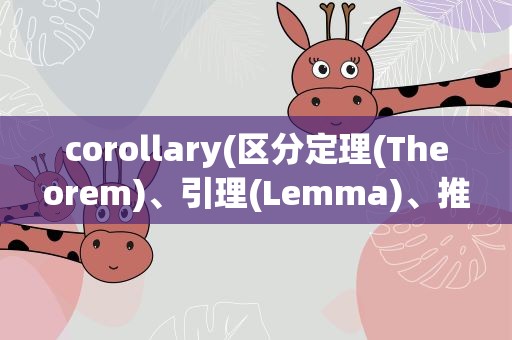区分定理(Theorem)、引理(Lemma)、推论(Corollary)等概念
名词解释

Theorem:就是定理,比较重要的,简写是Thm。
Lemma:小小的定理,通常是为了证明後面的定理,如果证明的篇幅很长时,可能会把证明拆成几个部分来叙述,虽然篇幅可能变多,但脉络却很清楚。
Corollary:推论。由定理立即可推知的结果。
Property:性质,结果虽然值得一记,却没定理来的深刻。
Proposition:有人翻译为「命题」,有些作者喜欢用,大概也可以算是比较简单的定理的一种称呼。
Claim:证明时先叙述一个结果,再作证明。看的人比较轻松。
Note:通常只是一个注解。
Remark:涉及一些结论,比较起来"Note"比较像说明,"remark"则常是非正式的定理。
首先、定义和公理是任何理论的基础,定义解决了概念的范畴,公理使得理论能够被人的理性所接受。
其次、定理和命题就是在定义和公理的基础上通过理性的加工使得理论的再延伸,我认为它们的区别主要在于,定理的理论高度比命题高些,定理主要是描述各定义(范畴)间的逻辑关系,命题一般描述的是某种对应关系(非范畴性的)。而推论就是某一定理的附属品,是该定理的简单应用。
最后、引理就是在证明某一定理时所必须用到的其它定理。而在一般情况下,就像前面所提到的定理的证明是依赖于定义和公理的。
1.引理和定理应该是根据文章目的不同而区分的,同样的论点在这篇文章可以是引理,在那篇文章可以是定理。
2.如果为了说明一个问题进行论证,但是在论证前需要证明若干个小问题,那么这些若干个小问题的结论就是引理,而这个问题的论证将会需要引用到前面的引理,该问题的结论就是定理。
3.引理是为定理作准备的。文章中的定理才是需要说明的主要问题或者目的。
就如doppler说的,
"Theorem"本身是一个大result
"Lemma"是prove“Theorem“之前用的一个result
"Corollary"是可以从"Theorem"里直接deduce/prove出来的result
"Proposition"是一个还无法大到变成"Theorem"的一个result(当作小theorem
)
(1)Definition(定义)------apreciseandunambiguousdescriptionofthemeaningofamathematicalterm.Itcharacterizesthemeaningofawordbygivingallthepropertiesandonlythosepropertiesthatmustbetrue.
(2)Theorem(定理)----amathematicalstatementthatisprovedusingrigorousmathemat-icalreasoning.Inamathematicalpaper,thetermtheoremisoftenreservedforthemostimportantresults.
(3)Lemma(引理)----aminorresultwhosesolepurposeistohelpinprovingatheorem.Itisasteppingstoneonthepathtoprovingatheorem.Veryoccasionallylemmascantakeonalifeoftheirown(Zorn'slemma,Urysohn'slemma,Burnside'slemma,Sperner'slemma).
(4)Corollary(推论)-----aresultinwhichthe(usuallyshort)proofreliesheavilyonagiventheorem(weoftensaythat\thisisacorollaryofTheoremA").
(5)Proposition(命题)-----aprovedandofteninterestingresult,butgenerallylessimportantthanatheorem.
(6)Conjecture(推测,猜想)----astatementthatisunproved,butisbelievedtobetrue(Collatzconjecture,Goldbachconjecture,twinprimeconjecture).
(7)Claim(断言)-----anassertionthatisthenproved.Itisoftenusedlikeaninformallemma.
(8)Axiom/Postulate------(公理/假定)astatementthatisassumedtobetruewithoutproof.Thesearethebasicbuildingblocksfromwhichalltheoremsareproved(Eu-clid'svepostulates,Zermelo-Frankelaxioms,Peanoaxioms).
(9)Identity(恒等式)-----amathematicalexpressiongivingtheequalityoftwo(oftenvariable)quantities(trigonometricidentities,Euler'sidentity).
(10)Paradox(悖论)----astatementthatcanbeshown,usingagivensetofaxiomsanddenitions,tobebothtrueandfalse.Paradoxesareoftenusedtoshowthe inconsistenciesinaawedtheory(Russell'sparadox).Thetermparadoxisoftenusedinformallytodescribeasurprisingorcounterintuitiveresultthatfollowsfromagivensetofrules(Banach-Tarskiparadox,Alabamaparadox,Gabriel'shorn).
http://blog.sina.com.cn/s/blog_a0e53bf70101jwv1.html
As a corollary to these remarks about teaching,it
由这些教学上说的话可得到一个推论,假设基因遗传特征被定义为固定和不可修改的是一个很普遍的谬误。

